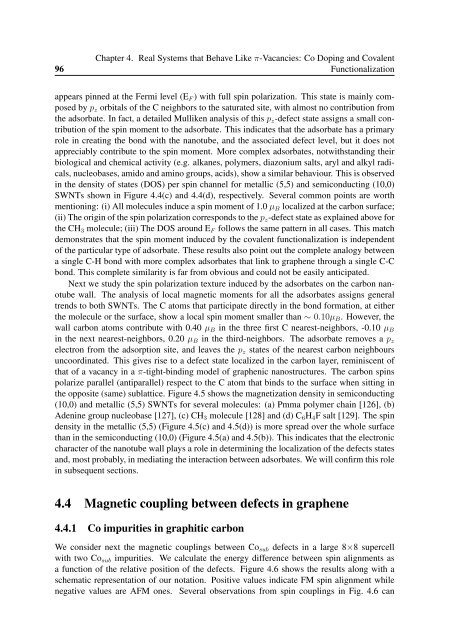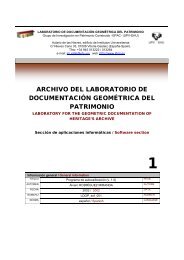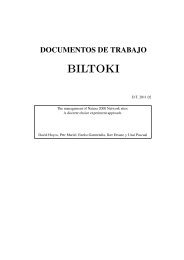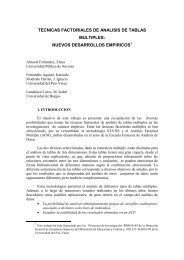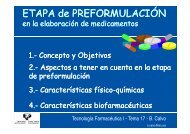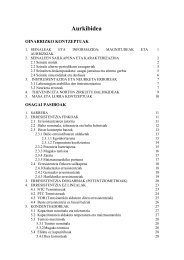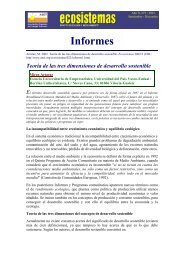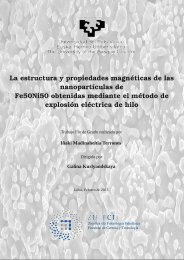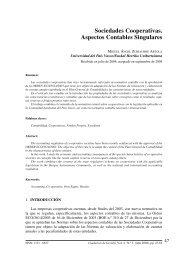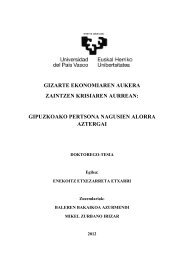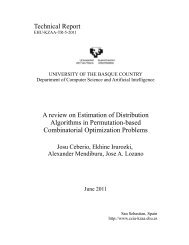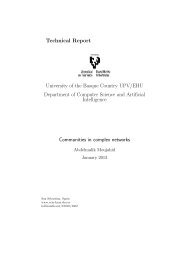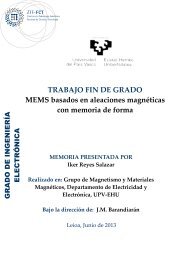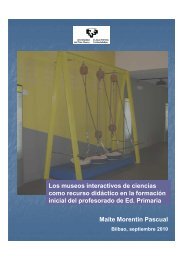Ï - ADDI
Ï - ADDI
Ï - ADDI
- No tags were found...
You also want an ePaper? Increase the reach of your titles
YUMPU automatically turns print PDFs into web optimized ePapers that Google loves.
96Chapter 4. Real Systems that Behave Like π-Vacancies: Co Doping and CovalentFunctionalizationappears pinned at the Fermi level (E F ) with full spin polarization. This state is mainly composedby p z orbitals of the C neighbors to the saturated site, with almost no contribution fromthe adsorbate. In fact, a detailed Mulliken analysis of this p z -defect state assigns a small contributionof the spin moment to the adsorbate. This indicates that the adsorbate has a primaryrole in creating the bond with the nanotube, and the associated defect level, but it does notappreciably contribute to the spin moment. More complex adsorbates, notwithstanding theirbiological and chemical activity (e.g. alkanes, polymers, diazonium salts, aryl and alkyl radicals,nucleobases, amido and amino groups, acids), show a similar behaviour. This is observedin the density of states (DOS) per spin channel for metallic (5,5) and semiconducting (10,0)SWNTs shown in Figure 4.4(c) and 4.4(d), respectively. Several common points are worthmentioning: (i) All molecules induce a spin moment of 1.0 µ B localized at the carbon surface;(ii) The origin of the spin polarization corresponds to the p z -defect state as explained above forthe CH 3 molecule; (iii) The DOS around E F follows the same pattern in all cases. This matchdemonstrates that the spin moment induced by the covalent functionalization is independentof the particular type of adsorbate. These results also point out the complete analogy betweena single C-H bond with more complex adsorbates that link to graphene through a single C-Cbond. This complete similarity is far from obvious and could not be easily anticipated.Next we study the spin polarization texture induced by the adsorbates on the carbon nanotubewall. The analysis of local magnetic moments for all the adsorbates assigns generaltrends to both SWNTs. The C atoms that participate directly in the bond formation, at eitherthe molecule or the surface, show a local spin moment smaller than ∼ 0.10µ B . However, thewall carbon atoms contribute with 0.40 µ B in the three first C nearest-neighbors, -0.10 µ Bin the next nearest-neighbors, 0.20 µ B in the third-neighbors. The adsorbate removes a p zelectron from the adsorption site, and leaves the p z states of the nearest carbon neighboursuncoordinated. This gives rise to a defect state localized in the carbon layer, reminiscent ofthat of a vacancy in a π-tight-binding model of graphenic nanostructures. The carbon spinspolarize parallel (antiparallel) respect to the C atom that binds to the surface when sitting inthe opposite (same) sublattice. Figure 4.5 shows the magnetization density in semiconducting(10,0) and metallic (5,5) SWNTs for several molecules: (a) Pmma polymer chain [126], (b)Adenine group nucleobase [127], (c) CH 3 molecule [128] and (d) C 6 H 4 F salt [129]. The spindensity in the metallic (5,5) (Figure 4.5(c) and 4.5(d)) is more spread over the whole surfacethan in the semiconducting (10,0) (Figure 4.5(a) and 4.5(b)). This indicates that the electroniccharacter of the nanotube wall plays a role in determining the localization of the defects statesand, most probably, in mediating the interaction between adsorbates. We will confirm this rolein subsequent sections.4.4 Magnetic coupling between defects in graphene4.4.1 Co impurities in graphitic carbonWe consider next the magnetic couplings between Co sub defects in a large 8×8 supercellwith two Co sub impurities. We calculate the energy difference between spin alignments asa function of the relative position of the defects. Figure 4.6 shows the results along with aschematic representation of our notation. Positive values indicate FM spin alignment whilenegative values are AFM ones. Several observations from spin couplings in Fig. 4.6 can


